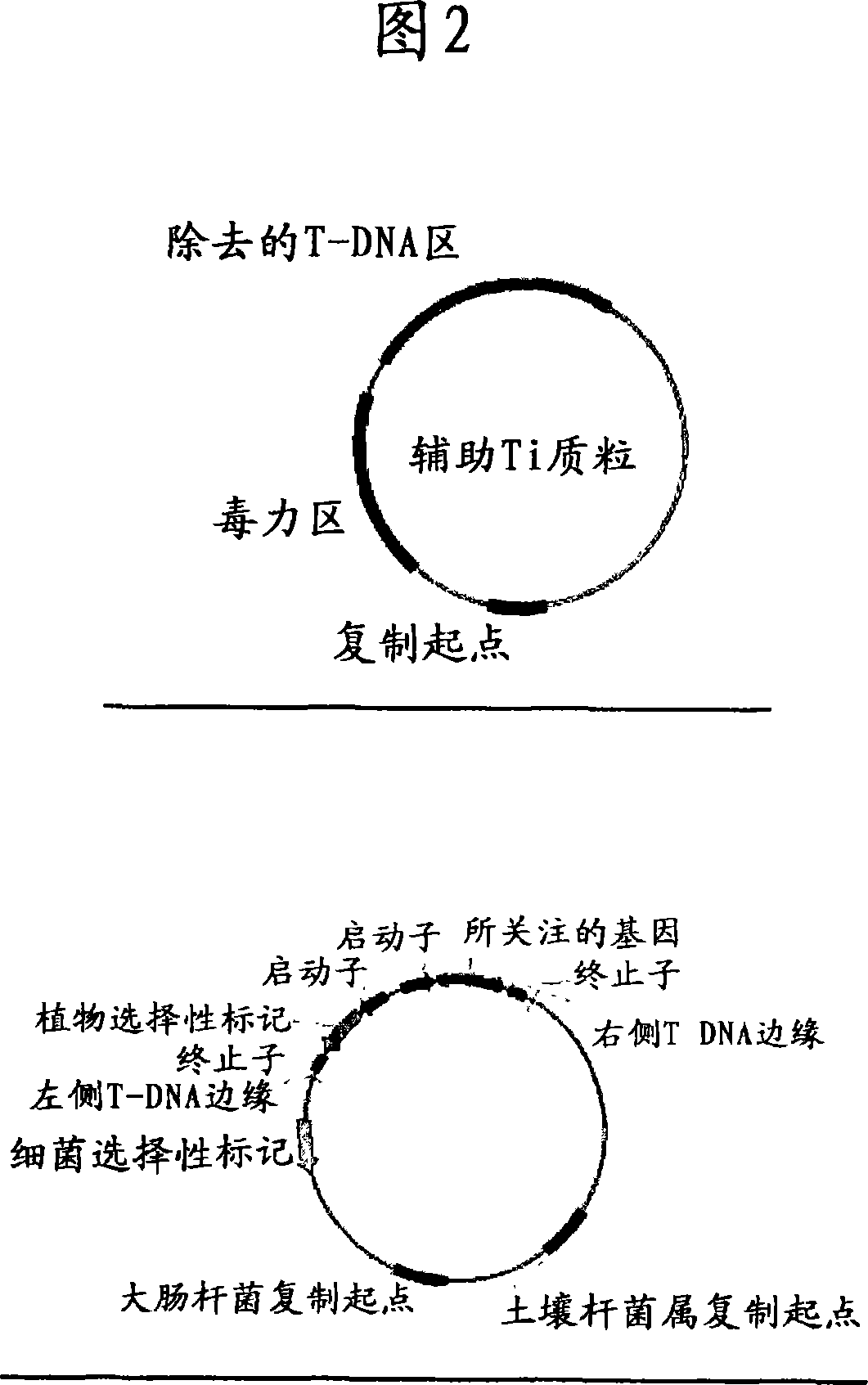Biological gene transfer system for eukaryotic cells
A gene and plant cell technology, applied in the field of biological gene transfer system for eukaryotic cells, can solve the problems of no DNA transfer to plants, unconfirmed causality, Ti plasmid functional testing, etc.
- Summary
- Abstract
- Description
- Claims
- Application Information
AI Technical Summary
Problems solved by technology
Method used
Image
Examples
Embodiment 1
[0080] Identification of strains that can transfer DNA
[0081] Test divergent bacteria to identify strains that can transform DNA. Strains are obtained from public genebanks or isolated from soil, other natural environments or any plant tissues. The bacterial species are identified by amplifying and sequencing information genes, including rDNA genes atpD and recA (Gaunt et al., IJSEM51: 2037-2048, 2001). The DNA sequence of the amplified product is compared with the known sequence of the specific bacteria. At this time, the presence of the amplified product of the expected size can be used for identification.
[0082] As mentioned above, suitable bacterial species naturally interact with plants in one way or another. They include plant endophytic bacteria that accompany plants, such as rhizobia, which are known to be useful for fixing nitrogen and can be utilized by plants. It also includes bacteria that can be attached to plants and have beneficial or neutral interactions with p...
Embodiment 2
[0099] Identification of Agrobacterium strains that can be used as Ti plasmid donors, isolation of Ti plasmids and transfer to other bacteria by electroporation
[0100] The Agrobacterium strain used as the source of the Ti plasmid is a highly virulent strain EHA105, which contains the Ti plasmid pEHA105, which is a derivative of the demethylated pTiBo542 (Hood et al., Transgenic Research 2: 208-218, 1993). To confirm this strain, Agrobacterium-specific was designed for the 16S rDNA gene (SEQ ID NOS: 22-23) and circular chromosome (SEQ ID NOS: 23-24) or the attS gene on the pAT giant plasmid (SEQ ID NOS: 25-26) Sexual genotyping primers. The primers for amplifying the sequence on the Ti plasmid, namely virG (SEQ ID NOS: 27-28) and virB gene (SEQ ID NOS: 31-32) were also designed. These primers were tested for specificity and effective amplification of Agrobacterium DNA. These primers were also tested on DNA templates prepared from all other strains tested for gene transfer. The re...
Embodiment 3
[0106] Construction of mobile Ti plasmid
[0107] Although Ti plasmids are generally self-conjugating plasmids, their movement under laboratory conditions is inconvenient due to the absence of specific components and conditions necessary to activate their adaptors. In this example, the demethylated Ti plasmid from EHA105 was made transitive by inserting the origin of transfer (oriT) of the RP4 / RK2 helper plasmid. An antibiotic resistance marker was also inserted into the Ti plasmid to enable selection of transconjugants. The resulting modified Ti plasmid can then be moved and selected by the transfer function provided by the RP4 / RK2 plasmid.
[0108]Using the vector inserted into the Ti plasmid, RP4oriT was inserted into the Ti plasmid by homologous recombination. Several types of vectors can be used, such as suicide vectors or broad host range vectors. The suicide vector contains an origin of replication that is not functional in Agrobacterium and one or more antibiotic selection...
PUM
 Login to View More
Login to View More Abstract
Description
Claims
Application Information
 Login to View More
Login to View More - R&D
- Intellectual Property
- Life Sciences
- Materials
- Tech Scout
- Unparalleled Data Quality
- Higher Quality Content
- 60% Fewer Hallucinations
Browse by: Latest US Patents, China's latest patents, Technical Efficacy Thesaurus, Application Domain, Technology Topic, Popular Technical Reports.
© 2025 PatSnap. All rights reserved.Legal|Privacy policy|Modern Slavery Act Transparency Statement|Sitemap|About US| Contact US: help@patsnap.com



